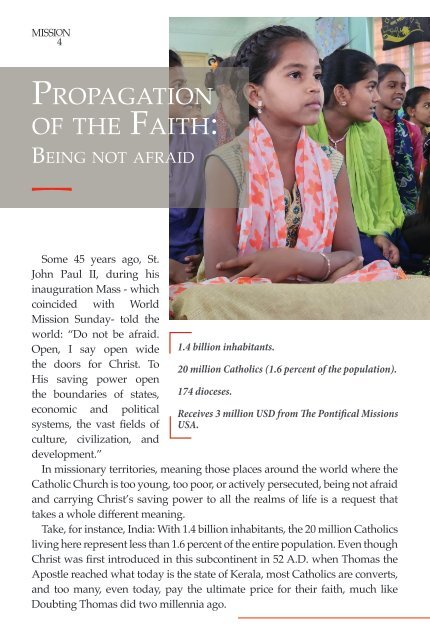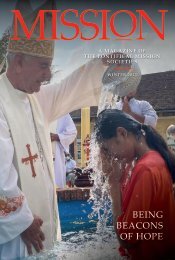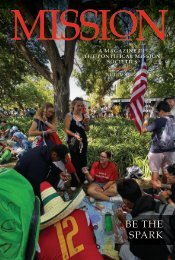Mission Magazine Summer 2023
With 1.4 billion citizens, India is the world’s largest country, and much like the United States it is home to some 20 million Catholics. The difference lies in the fact that in this Asian subcontinent they represent less than 1.6 percent of the total population, while here Catholics are the second largest religious group, representing 23 percent of all Americans. Hence, we dedicate an entire edition of MISSION Magazine to document the joys and struggles of India, a land that first heard the Gospel from the Apostle St. Thomas.
With 1.4 billion citizens, India is the world’s largest country, and much like the United States it is home to some 20 million Catholics. The difference lies in the fact that in this Asian subcontinent they represent less than 1.6 percent of the total population, while here Catholics are the second largest religious group, representing 23 percent of all Americans.
Hence, we dedicate an entire edition of MISSION Magazine to document the joys and struggles of India, a land that first heard the Gospel from the
Apostle St. Thomas.
Create successful ePaper yourself
Turn your PDF publications into a flip-book with our unique Google optimized e-Paper software.
4 5<br />
Propagation<br />
of the Faith:<br />
Being not afraid<br />
Some 45 years ago, St.<br />
John Paul II, during his<br />
inauguration Mass - which<br />
coincided with World<br />
<strong>Mission</strong> Sunday- told the<br />
world: “Do not be afraid.<br />
Open, I say open wide<br />
the doors for Christ. To<br />
His saving power open<br />
the boundaries of states,<br />
economic and political<br />
systems, the vast fields of<br />
culture, civilization, and<br />
development.”<br />
1.4 billion inhabitants.<br />
20 million Catholics (1.6 percent of the population).<br />
174 dioceses.<br />
Receives 3 million USD from The Pontifical <strong>Mission</strong>s<br />
USA.<br />
In missionary territories, meaning those places around the world where the<br />
Catholic Church is too young, too poor, or actively persecuted, being not afraid<br />
and carrying Christ’s saving power to all the realms of life is a request that<br />
takes a whole different meaning.<br />
Take, for instance, India: With 1.4 billion inhabitants, the 20 million Catholics<br />
living here represent less than 1.6 percent of the entire population. Even though<br />
Christ was first introduced in this subcontinent in 52 A.D. when Thomas the<br />
Apostle reached what today is the state of Kerala, most Catholics are converts,<br />
and too many, even today, pay the ultimate price for their faith, much like<br />
Doubting Thomas did two millennia ago.<br />
This August marks the 15th anniversary of the carnage that descended upon<br />
the impoverished Christian minority in Kandhamal, a district of the eastern<br />
Indian state of Odisha. A series of riots led by radical Hindus left roughly 100<br />
people dead, thousands injured, 300 churches and 6,000 homes destroyed, and<br />
50,000 people displaced, many forced to hide in nearby forests where more<br />
died of hunger and venomous snakebites.<br />
The violence was carried out by mobs adorned with saffron headbands,<br />
a sign of right-wing Hindu militancy, and shouting slogans such as “Jai shri<br />
ram!” (Victory to the Hindu god). Attackers wielded rods, tridents, swords,<br />
firearms, kerosene, and even acid. Christians who refused to deny Christ were<br />
buried alive, set ablaze, or gutted in front of their children.<br />
In many cases, the government refused to acknowledge the dead because the<br />
wind had carried the ashes away, and most of those killed were so poor that<br />
they had never even been registered as having been born.<br />
To be sure, the 2008 pogrom was hardly an isolated incident. Violence against<br />
Christians throughout India continues routinely today, although on a smaller<br />
scale. In December, the U.S. Commission on International Religious Freedom<br />
expressed “outrage” that India had not been designated a “country of particular<br />
concern” by the U.S. State Department’s religious freedom report, claiming the<br />
omission was tantamount to “turning a blind eye (…) to particularly severe<br />
religious freedom violations.”<br />
For example, Christians are passed on for government jobs. State laws<br />
make it virtually impossible to open new parishes in many regions. The<br />
Dalits -formerly known as untouchables in India’s<br />
caste system- lose the affirmative actions taken by<br />
the national government to make up for historical<br />
oppressions. The government’s justification for<br />
depriving Dalit Christians of their rights is that they<br />
have the support of Christians worldwide.<br />
Yet despite the constant threat of physical violence<br />
faced by India’s Christian minority, according to<br />
Cardinal Oswald Gracias, archbishop of Mumbai,<br />
Catholics are a “vibrant community, seen not only<br />
in our attendance at Sunday Mass, but also in the<br />
involvement in different activities.”








